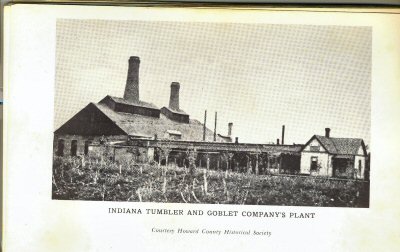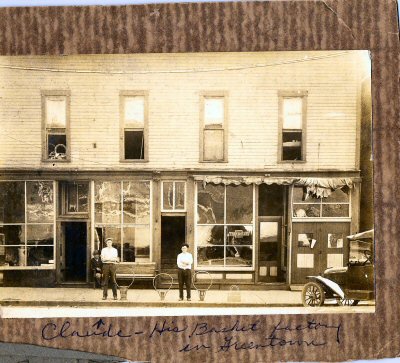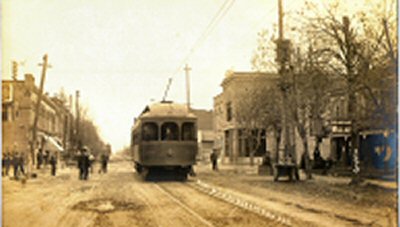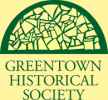





The History of Greentown
A Short History of Greentown and Eastern Howard County
Compiled from the following sources: Howard County News Centennial Section, September 24, 1948; Greentown Sesquicentennial Commemorative History 1998; Howard County: A Pictorial History by Ned Booher, 1994
In The Beginning
Archaeological evidence suggests that Howard County, Indiana, has been occupied by humans since at least 8000 B.C. The Miami Indians who called eastern Howard County their home probably did not have permanent villages here, but used the region as hunting and gathering grounds. The countryside was a dense and rather swampy maple forest, the resource of the Miamis for making maple sugar and molasses as well as wooden tools and vessels for their seasonal activities.
Under the terms of the treaty of 1818 which ended the War of 1812 between the U.S. and Britain, the Miamis ceded a large tract of land in central Indiana within which was established the Big Miami Reserve. In 1834 and 1838 they signed treaties and sold lands in the reserve to the state of Indiana. In 1840 all Indian title to the Miami Reserve was relinquished in the Treaty of the Forks of the Wabash, and by 1848 the federal government removed most of the Indians to Kansas.
Early White Settlers in Liberty Township
In 1842-43 the first white settler in this new area, Henry Bailly, came upon the very marshy, forested land lying north of the Wildcat in the vicinity of what would later be called Jerome, and made his way northwest along the creek until he reached Sho-co-mo's village, one of two Indian villages of 20 or 30 cabins about 1 ½ miles south of present-day Greentown. He lived here while he built a cabin on his claim near the future Jerome. He brought his large family to develop this claim and a brisk trade with the Indians. The next year he sold his claim and located a new claim on the present site of Greentown, which was later sold to Charles O. Fry in 1845. With the rapid influx of white settlers, Bailly sold all of his other claims in 1850 and moved west to Iowa.
Arriving in the area in 1844, Joshua Freeman settled on a claim near the Indian villages, pursuing his occupation of hunting and trapping. In 1846 he sold out to Absalom Lamb. Besides traders, the first business firm was a tavern opened by Jacob Davis, Sr., in 1846 in the western part of the future Liberty Township on the Kokomo-Jonesboro Road. In 1849 a combination mill was begun on the Wildcat by Luther Seagraves and finished by Mr. Jenkins. In 1850 William Lindley built a saw mill on the Wildcat just south of Greentown which he sold to H.N. Dorman. With the addition of steam, it operated until the end of the century. Ira and O.P. Hollingsworth built a steam sawmill inside the present limits of Greentown in 1852. Valentine Sommers built a saw mill in Greentown in the 1850s. Others were built near Greentown but did not remain in business for long.
The first school in present-day Liberty Township was conducted by Miss Lillis Cook in a log cabin about 1 ½ mile northwest of Greentown for three months by subscription during the winter of 1848-49.
Charles O. Fry was a stable resident and made considerable improvements during a period of 16 years in this community. James Morton settled east of the Fry claim, becoming a prominent farmer in the area. In 1845 came the families of William Cox, John Sharpe, Matthew Golden, James Lindley, and Jesse Osborne. The following years would witness the influx of several more families who set up permanent residence in the Greentown area.
Compiled from the following sources: Howard County News Centennial Section, September 24, 1948; Greentown Sesquicentennial Commemorative History 1998; Howard County: A Pictorial History by Ned Booher, 1994
In The Beginning
Archaeological evidence suggests that Howard County, Indiana, has been occupied by humans since at least 8000 B.C. The Miami Indians who called eastern Howard County their home probably did not have permanent villages here, but used the region as hunting and gathering grounds. The countryside was a dense and rather swampy maple forest, the resource of the Miamis for making maple sugar and molasses as well as wooden tools and vessels for their seasonal activities.
Under the terms of the treaty of 1818 which ended the War of 1812 between the U.S. and Britain, the Miamis ceded a large tract of land in central Indiana within which was established the Big Miami Reserve. In 1834 and 1838 they signed treaties and sold lands in the reserve to the state of Indiana. In 1840 all Indian title to the Miami Reserve was relinquished in the Treaty of the Forks of the Wabash, and by 1848 the federal government removed most of the Indians to Kansas.
Early White Settlers in Liberty Township
In 1842-43 the first white settler in this new area, Henry Bailly, came upon the very marshy, forested land lying north of the Wildcat in the vicinity of what would later be called Jerome, and made his way northwest along the creek until he reached Sho-co-mo's village, one of two Indian villages of 20 or 30 cabins about 1 ½ miles south of present-day Greentown. He lived here while he built a cabin on his claim near the future Jerome. He brought his large family to develop this claim and a brisk trade with the Indians. The next year he sold his claim and located a new claim on the present site of Greentown, which was later sold to Charles O. Fry in 1845. With the rapid influx of white settlers, Bailly sold all of his other claims in 1850 and moved west to Iowa.
Arriving in the area in 1844, Joshua Freeman settled on a claim near the Indian villages, pursuing his occupation of hunting and trapping. In 1846 he sold out to Absalom Lamb. Besides traders, the first business firm was a tavern opened by Jacob Davis, Sr., in 1846 in the western part of the future Liberty Township on the Kokomo-Jonesboro Road. In 1849 a combination mill was begun on the Wildcat by Luther Seagraves and finished by Mr. Jenkins. In 1850 William Lindley built a saw mill on the Wildcat just south of Greentown which he sold to H.N. Dorman. With the addition of steam, it operated until the end of the century. Ira and O.P. Hollingsworth built a steam sawmill inside the present limits of Greentown in 1852. Valentine Sommers built a saw mill in Greentown in the 1850s. Others were built near Greentown but did not remain in business for long.
The first school in present-day Liberty Township was conducted by Miss Lillis Cook in a log cabin about 1 ½ mile northwest of Greentown for three months by subscription during the winter of 1848-49.
Charles O. Fry was a stable resident and made considerable improvements during a period of 16 years in this community. James Morton settled east of the Fry claim, becoming a prominent farmer in the area. In 1845 came the families of William Cox, John Sharpe, Matthew Golden, James Lindley, and Jesse Osborne. The following years would witness the influx of several more families who set up permanent residence in the Greentown area.
Early White Settlers in Jackson Township
In 1845 the first white settler,
Joseph Hockett, settled in the
northeast part of what would
become Jackson Township. He was
soon followed by Turner Sullivan
and Samuel Darby. The first
Jackson Township school was
taught by David Stanfield in 1849
in a little, abandoned log cabin on
the William Braden farm 1 ¾ miles
south of present-day Converse.
Sycamore grew from the site of a
steam saw mill erected in 1851 by
Daniel Cate and Joseph Fleeks. In
the early years several other saw
mills were constructed throughout
Jackson Township where there
was an abundance of timber, but by
the end of the 19th century the timber supply was largely depleted.
Early White Settlers in Union Township
The first settler to arrive in what would be known as Union Township was the earlier-mentioned Henry Bailly in 1842-1843. The next year he was followed by Thomas Moorman, C.P. Baldwin, James Lancaster, and Elliott Mason. These and later settlers cut their own road through the thick forests to clear the land and build their cabins. The first school of the future Union Township was by subscription and held in the house of Charles P. Baldwin, taught by his wife, Rachel, in 1845.
The first settler to arrive in what would be known as Union Township was the earlier-mentioned Henry Bailly in 1842-1843. The next year he was followed by Thomas Moorman, C.P. Baldwin, James Lancaster, and Elliott Mason. These and later settlers cut their own road through the thick forests to clear the land and build their cabins. The first school of the future Union Township was by subscription and held in the house of Charles P. Baldwin, taught by his wife, Rachel, in 1845.
Organization of eastern Howard County
Howard and Tipton counties were the last two Indiana counties to be created in 1844 because of the Big Miami Reserve. The area was an unbroken and undeveloped expanse of forests and swamps. Green and Jackson Townships were formed in 1844 when Richardville County (later Howard County) was first divided into townships. In December 1846 Green Township was divided into two townships, the north becoming Jackson Township. The name Green disappeared in 1853 when these two townships were divided to make three townships: Liberty, Union, and Jackson.
Howard and Tipton counties were the last two Indiana counties to be created in 1844 because of the Big Miami Reserve. The area was an unbroken and undeveloped expanse of forests and swamps. Green and Jackson Townships were formed in 1844 when Richardville County (later Howard County) was first divided into townships. In December 1846 Green Township was divided into two townships, the north becoming Jackson Township. The name Green disappeared in 1853 when these two townships were divided to make three townships: Liberty, Union, and Jackson.
Greentown Emerges
Jerome was founded as a trading point in 1847, but there was a demand for a more centrally located point. The site for Greentown selected in 1848 was that of an old Indian village. A survey for the town was made, and a plat was placed on file on April 14, 1848. One part of the town was laid out by Charles O. Fry, another by Jesse Osborne, and a third by Tarver Seagraves.
Different stories have emerged over the years regarding why the name of Greentown was chosen. An obvious one is that the area was a grassy clearing in a deep, green forest. Another suggestion was that eastern Howard County was called at this time Green Township. A third story centers around the town being named after an Indian chief named Green.
The first lot in the newly platted Greentown was purchased by Dr. James Barrett who built a log structure near the corner of Main and Howard Streets. In 1848 the second building was a log structure erected by L.W. Bacon on the northeast corner of Main and Meridian Streets, becoming the first general store in the new town. A second store was opened by C.O. Fry on the southwest corner of Main and Meridian.
With a growing population came the need for improved roads. Early male residents were required to work a certain number of days on building roads. In 1869 the citizens undertook the building of the Kokomo Greentown Jerome Gravel Road; it was along the north side of the Wildcat and had two toll gates. Today we call it Sycamore Road, running from Kokomo to 780 East and thence southeast into Greentown. At the same time the Kokomo Greentown Gravel Road was built on today's 50 North. These two roads joined on 50 North and 780 East and came together into Greentown.
During the growth years 1850-1883 Greentown emerged from isolation with improved roads and transportation. In 1871 the town's growth and prosperity were assured with the coming of the Toledo Delphos St. Louis railroad, making it the shipping point for eastern Howard County. Greentown was incorporated in 1873 and had a population of 550.
Jerome was founded as a trading point in 1847, but there was a demand for a more centrally located point. The site for Greentown selected in 1848 was that of an old Indian village. A survey for the town was made, and a plat was placed on file on April 14, 1848. One part of the town was laid out by Charles O. Fry, another by Jesse Osborne, and a third by Tarver Seagraves.
Different stories have emerged over the years regarding why the name of Greentown was chosen. An obvious one is that the area was a grassy clearing in a deep, green forest. Another suggestion was that eastern Howard County was called at this time Green Township. A third story centers around the town being named after an Indian chief named Green.
The first lot in the newly platted Greentown was purchased by Dr. James Barrett who built a log structure near the corner of Main and Howard Streets. In 1848 the second building was a log structure erected by L.W. Bacon on the northeast corner of Main and Meridian Streets, becoming the first general store in the new town. A second store was opened by C.O. Fry on the southwest corner of Main and Meridian.
With a growing population came the need for improved roads. Early male residents were required to work a certain number of days on building roads. In 1869 the citizens undertook the building of the Kokomo Greentown Jerome Gravel Road; it was along the north side of the Wildcat and had two toll gates. Today we call it Sycamore Road, running from Kokomo to 780 East and thence southeast into Greentown. At the same time the Kokomo Greentown Gravel Road was built on today's 50 North. These two roads joined on 50 North and 780 East and came together into Greentown.
During the growth years 1850-1883 Greentown emerged from isolation with improved roads and transportation. In 1871 the town's growth and prosperity were assured with the coming of the Toledo Delphos St. Louis railroad, making it the shipping point for eastern Howard County. Greentown was incorporated in 1873 and had a population of 550.
Boom and Bust
The first natural gas well in Greentown came in 1877, located in the eastern part of town near the railroad. The supply of gas seemed inexhaustible at the time, and it was burned day and night. In 1894 prominent town members convinced D.C. Jenkins to locate the glass manufacturing plant, Indiana Tumbler and Goblet Factory, just south of the railroad at the east end of town. It was sold in 1899 to the National Glass Company who continued to operate until 1903 when it was completely destroyed by fire. It produced distinctive glassware which is highly collectible today.
The glass factory had marked the town's principal period of industrial activity. With the loss of the factory and the decline in supply of natural gas, Greentown lost 500 in population, and local businesses faced lost revenues.
The first natural gas well in Greentown came in 1877, located in the eastern part of town near the railroad. The supply of gas seemed inexhaustible at the time, and it was burned day and night. In 1894 prominent town members convinced D.C. Jenkins to locate the glass manufacturing plant, Indiana Tumbler and Goblet Factory, just south of the railroad at the east end of town. It was sold in 1899 to the National Glass Company who continued to operate until 1903 when it was completely destroyed by fire. It produced distinctive glassware which is highly collectible today.
The glass factory had marked the town's principal period of industrial activity. With the loss of the factory and the decline in supply of natural gas, Greentown lost 500 in population, and local businesses faced lost revenues.
Above is a picture of the Indiana
Tumbler and Goblet factory - circa
1877.
To the right is a picture of the Basket Factory which illustrates another type of industry.
To the right is a picture of the Basket Factory which illustrates another type of industry.
Transportation to a Better Future
From 1902 until 1930 the interurban railroad came through Greentown and offered rural and town folks frequent and modern transportation to Kokomo and Marion. As improved roads, buses, and automobiles replaced the interurban, Greentown became more than just an agricultural trading center. Many workers in Kokomo and Marion established their homes in eastern Howard County, enabling the area to develop as a suburban community and small business center.
From 1902 until 1930 the interurban railroad came through Greentown and offered rural and town folks frequent and modern transportation to Kokomo and Marion. As improved roads, buses, and automobiles replaced the interurban, Greentown became more than just an agricultural trading center. Many workers in Kokomo and Marion established their homes in eastern Howard County, enabling the area to develop as a suburban community and small business center.
Compiled in August 2010
The above map from 1876 shows the locations of schools, churches, cemeteries, and
mills.
This site is hosted by Kling's Computers, Inc.














